本篇内容介绍了“如何用Python写出心血管疾病预测模型”的有关知识,在实际案例的操作过程中,不少人都会遇到这样的困境,接下来就让小编带领大家学习一下如何处理这些情况吧!希望大家仔细阅读,能够学有所成!
01 数据理解
数据取自于kaggle平台分享的心血管疾病数据集,共有13个字段299 条病人诊断记录。具体的字段概要如下:
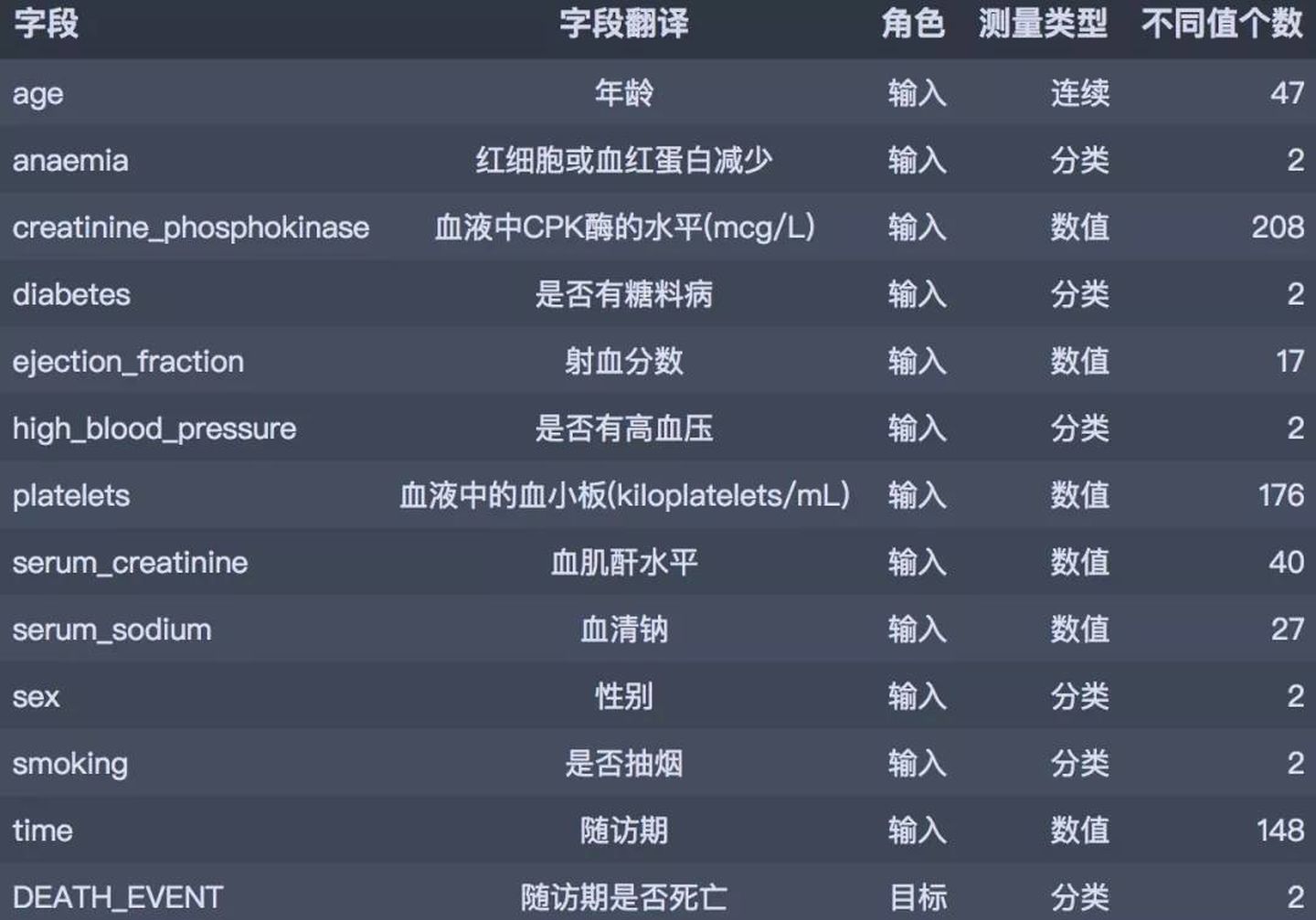
02数据读入和初步处理
首先导入所需包。
# 数据整理 import numpy as np import pandas as pd # 可视化 import matplotlib.pyplot as plt import seaborn as sns import plotly as py import plotly.graph_objs as go import plotly.express as px import plotly.figure_factory as ff # 模型建立 from sklearn.linear_model import LogisticRegression from sklearn.tree import DecisionTreeClassifier from sklearn.ensemble import GradientBoostingClassifier, RandomForestClassifier import lightgbm # 前处理 from sklearn.preprocessing import StandardScaler # 模型评估 from sklearn.model_selection import train_test_split, GridSearchCV from sklearn.metrics import plot_confusion_matrix, confusion_matrix, f1_score
加载并预览数据集:
# 读入数据
df = pd.read_csv('./data/heart_failure.csv')
df.head()
03探索性分析
1. 描述性分析
df.describe().T
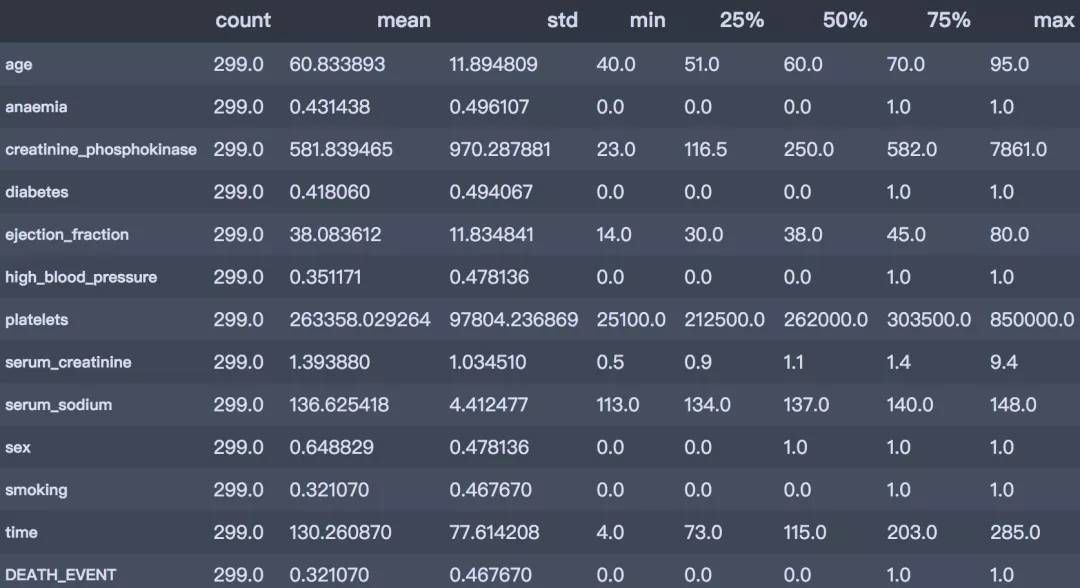
从上述描述性分析结果简单总结如下:
是否死亡:平均的死亡率为32%;
年龄分布:平均年龄60岁,最小40岁,最大95岁
是否有糖尿病:有41.8%患有糖尿病
是否有高血压:有35.1%患有高血压
是否抽烟:有32.1%有抽烟
2. 目标变量
# 产生数据 death_num = df['DEATH_EVENT'].value_counts() death_num = death_num.reset_index() # 饼图 fig = px.pie(death_num, names='index', values='DEATH_EVENT') fig.update_layout(title_text='目标变量DEATH_EVENT的分布') py.offline.plot(fig, filename='./html/目标变量DEATH_EVENT的分布.html')
总共有299人,其中随访期未存活人数96人,占总人数的32.1%
3. 贫血
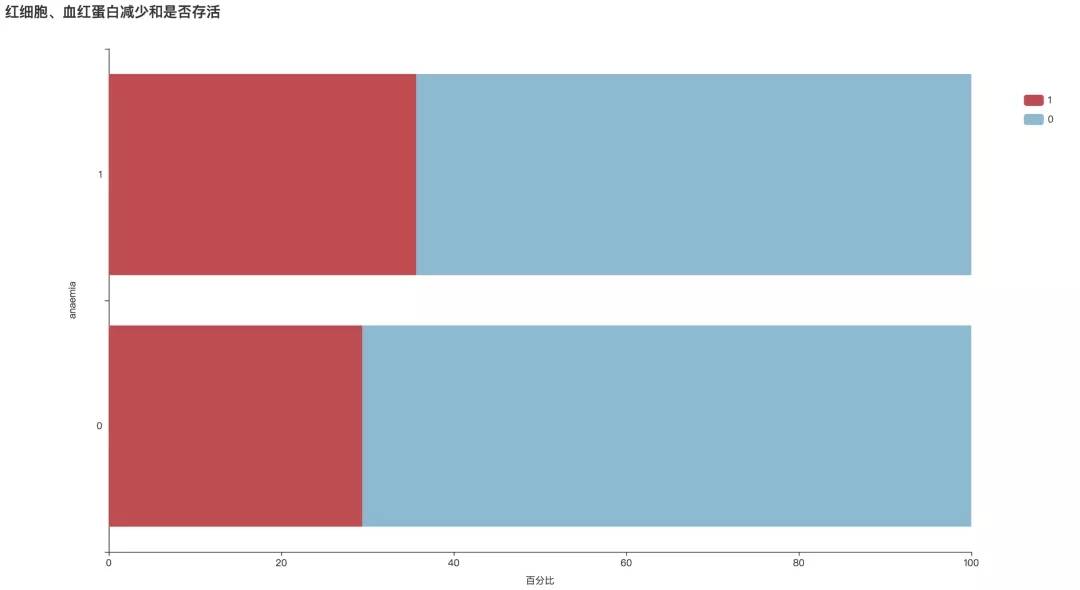
从图中可以看出,有贫血症状的患者死亡概率较高,为35.66%。
bar1 = draw_categorical_graph(df['anaemia'], df['DEATH_EVENT'], title='红细胞、血红蛋白减少和是否存活')
bar1.render('./html/红细胞血红蛋白减少和是否存活.html')4. 年龄
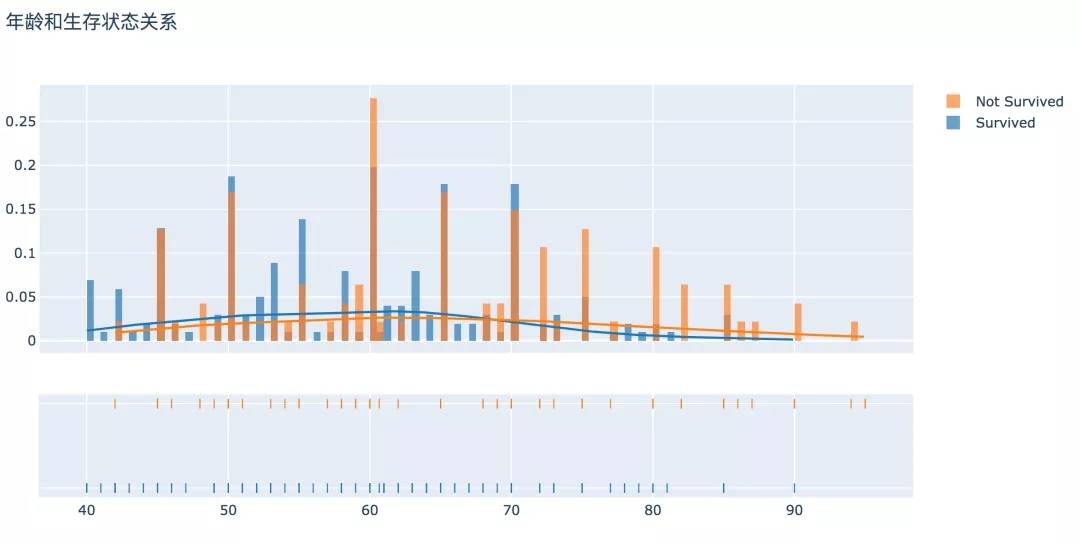
从直方图可以看出,在患心血管疾病的病人中年龄分布差异较大,表现趋势为年龄越大,生存比例越低、死亡的比例越高。
# 产生数据 surv = df[df['DEATH_EVENT'] == 0]['age'] not_surv = df[df['DEATH_EVENT'] == 1]['age'] hist_data = [surv, not_surv] group_labels = ['Survived', 'Not Survived'] # 直方图 fig = ff.create_distplot(hist_data, group_labels, bin_size=0.5) fig.update_layout(title_text='年龄和生存状态关系') py.offline.plot(fig, filename='./html/年龄和生存状态关系.html')
5. 年龄/性别
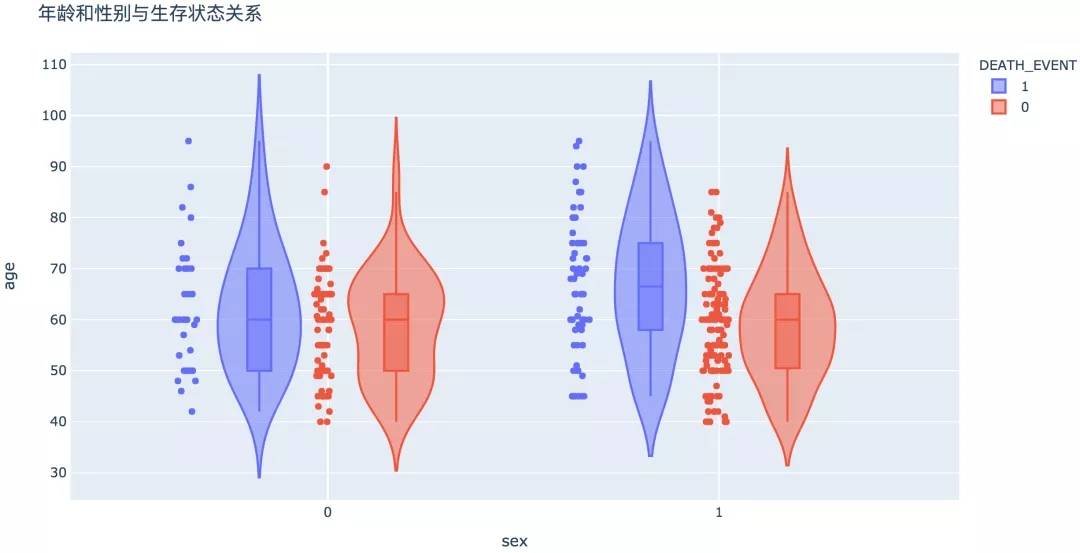
从分组统计和图形可以看出,不同性别之间生存状态没有显著性差异。在死亡的病例中,男性的平均年龄相对较高。
6. 年龄/抽烟
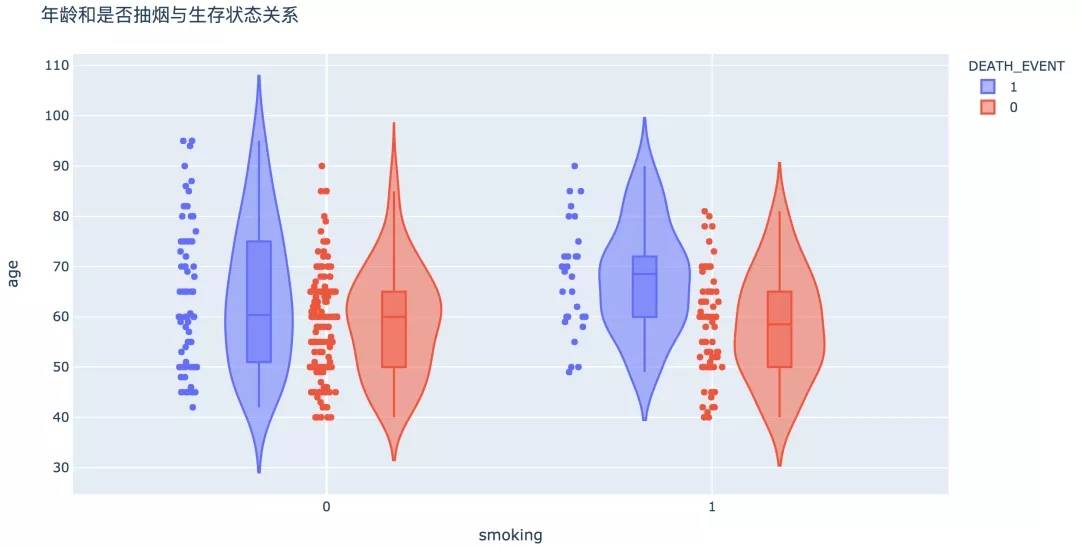
数据显示,整体来看,是否抽烟与生存与否没有显著相关性。但是当我们关注抽烟的人群中,年龄在50岁以下生存概率较高。
7. 磷酸肌酸激酶(CPK)
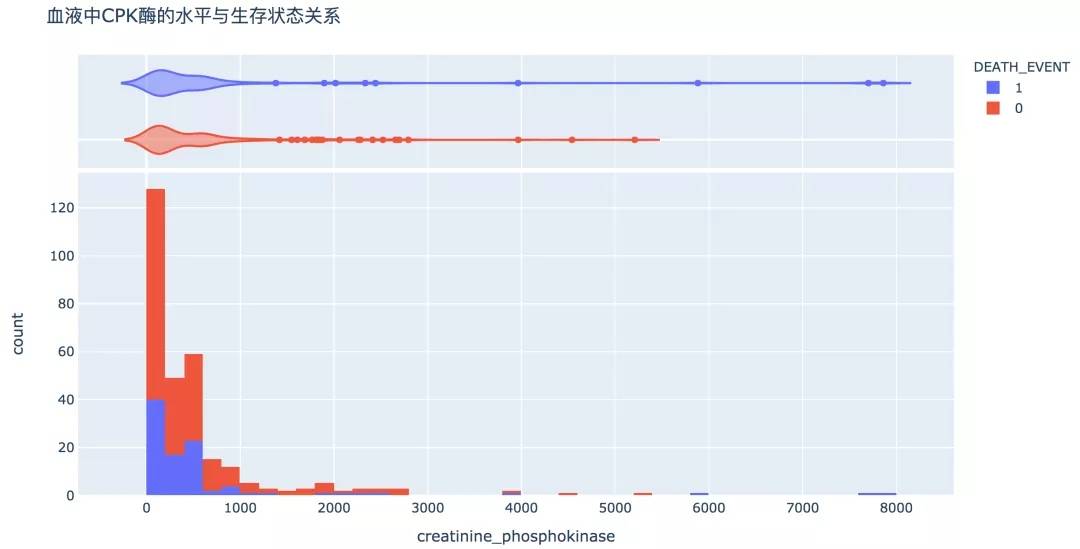
从直方图可以看出,血液中CPK酶的水平较高的人群死亡的概率较高。
8. 射血分数
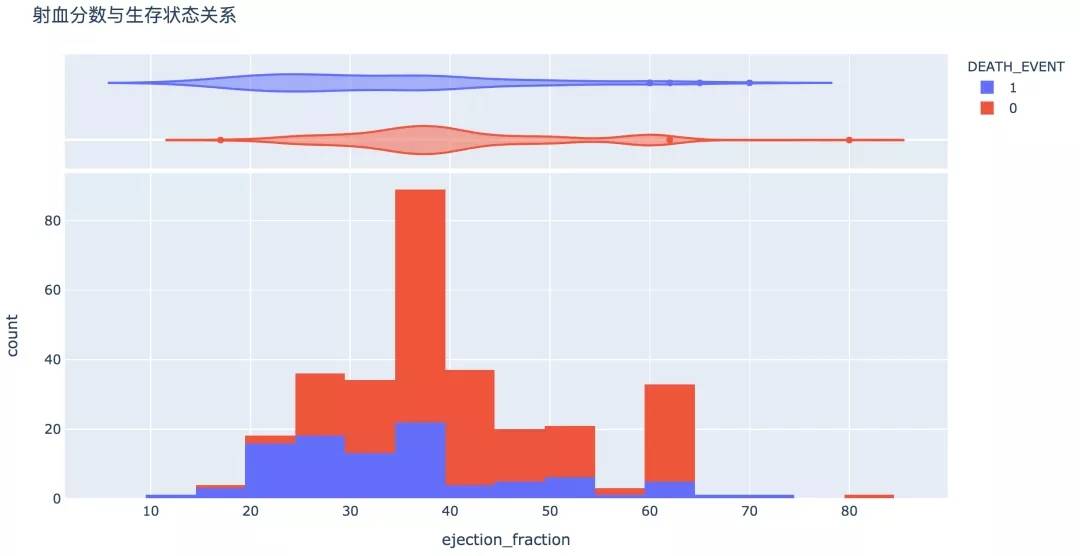
射血分数代表了心脏的泵血功能,过高和过低水平下,生存的概率较低。
9. 血小板
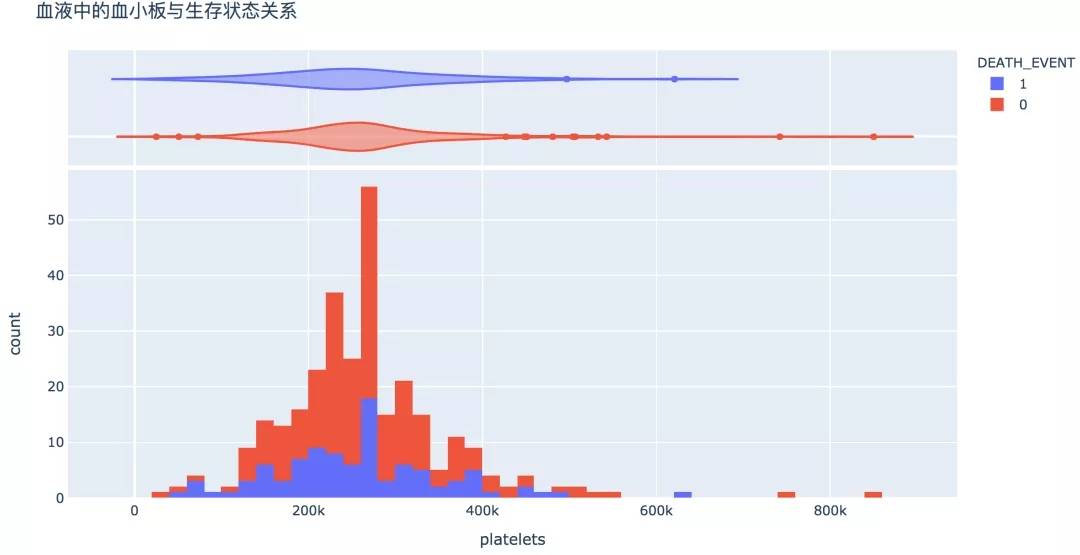
血液中血小板(100~300)×10^9个/L,较高或较低的水平则代表不正常,存活的概率较低。
10. 血肌酐水平
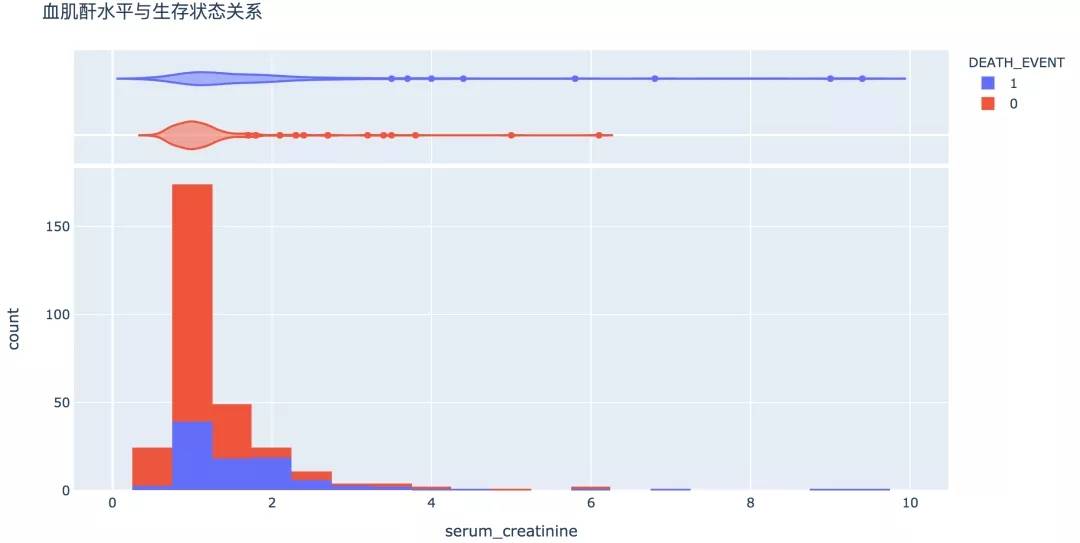
血肌酐是检测肾功能的最常用指标,较高的指数代表肾功能不全、肾衰竭,有较高的概率死亡。
11. 血清钠水平
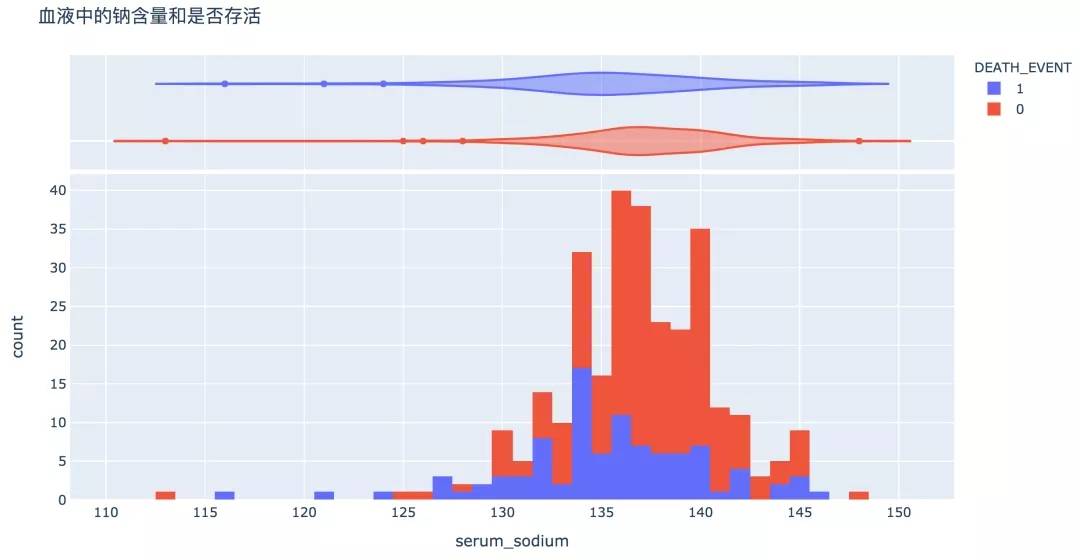
图形显示,血清钠较高或较低往往伴随着风险。
12. 相关性分析
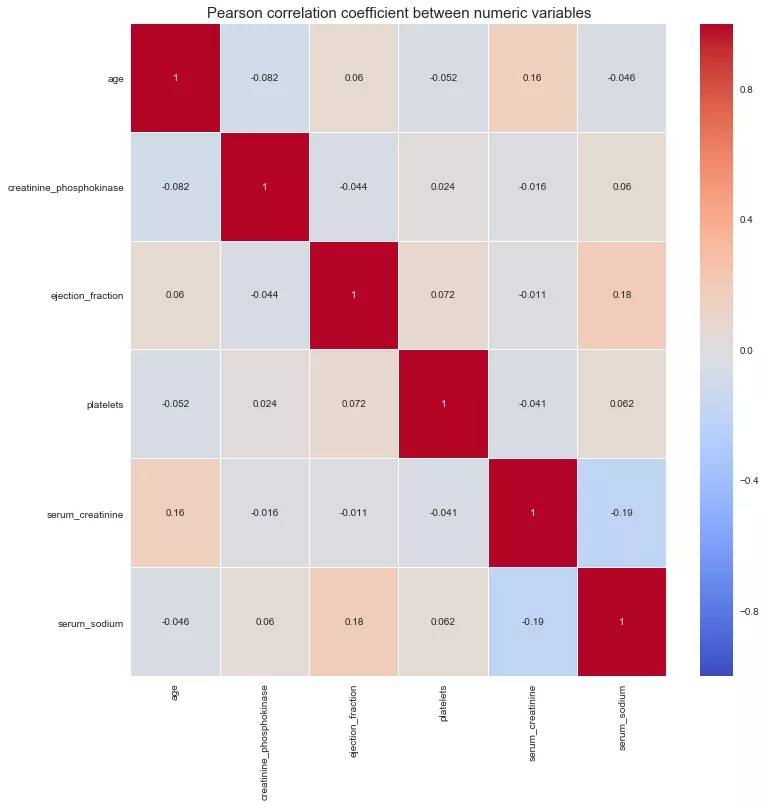
从数值型属性的相关性图可以看出,变量之间没有显著的共线性关系。
num_df = df[['age', 'creatinine_phosphokinase', 'ejection_fraction', 'platelets',
'serum_creatinine', 'serum_sodium']]
plt.figure(figsize=(12, 12))
sns.heatmap(num_df.corr(), vmin=-1, cmap='coolwarm', linewidths=0.1, annot=True)
plt.title('Pearson correlation coefficient between numeric variables', fontdict={'fontsize': 15})
plt.show()04特征筛选
我们使用统计方法进行特征筛选,目标变量DEATH_EVENT是分类变量时,当自变量是分类变量,使用卡方鉴定,自变量是数值型变量,使用方差分析。
# 划分X和y
X = df.drop('DEATH_EVENT', axis=1)
y = df['DEATH_EVENT']
from feature_selection import Feature_select
fs = Feature_select(num_method='anova', cate_method='kf')
X_selected = fs.fit_transform(X, y)
X_selected.head()
2020 17:19:49 INFO attr select success!
After select attr: ['serum_creatinine', 'serum_sodium', 'ejection_fraction', 'age', 'time']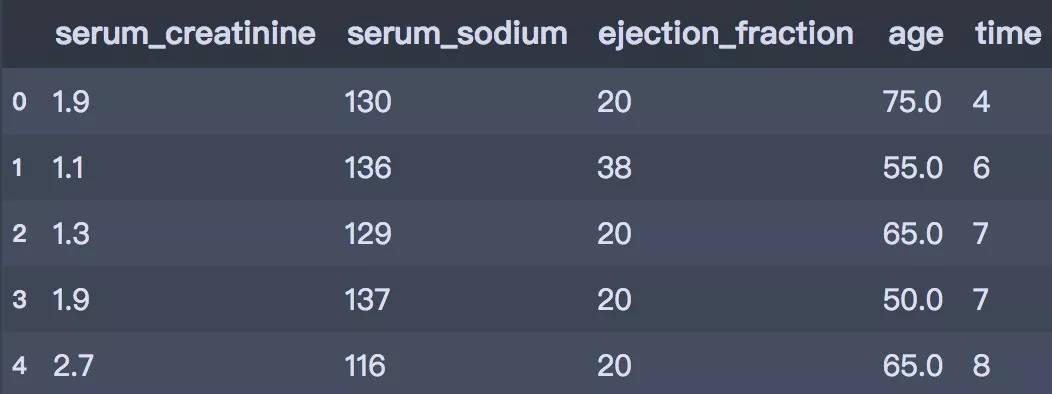
05数据建模
首先划分训练集和测试集。
# 划分训练集和测试集
Features = X_selected.columns
X = df[Features]
y = df["DEATH_EVENT"]
X_train, X_test, y_train, y_test = train_test_split(X, y, test_size=0.2, stratify=y,
random_state=2020)
# 标准化
scaler = StandardScaler()
scaler_Xtrain = scaler.fit_transform(X_train)
scaler_Xtest = scaler.fit_transform(X_test)
lr = LogisticRegression()
lr.fit(scaler_Xtrain, y_train)
test_pred = lr.predict(scaler_Xtest)
# F1-score
print("F1_score of LogisticRegression is : ", round(f1_score(y_true=y_test, y_pred=test_pred),2))我们使用决策树进行建模,设置特征选择标准为gini,树的深度为5。输出混淆矩阵图:在这个案例中,1类是我们关注的对象。
# DecisionTreeClassifier
clf = DecisionTreeClassifier(criterion='gini', max_depth=5, random_state=1)
clf.fit(X_train, y_train)
test_pred = clf.predict(X_test)
# F1-score
print("F1_score of DecisionTreeClassifier is : ", round(f1_score(y_true=y_test, y_pred=test_pred),2))
# 绘图
plt.figure(figsize=(10, 7))
plot_confusion_matrix(clf, X_test, y_test, cmap='Blues')
plt.title("DecisionTreeClassifier - Confusion Matrix", fontsize=15)
plt.xticks(range(2), ["Heart Not Failed","Heart Fail"], fontsize=12)
plt.yticks(range(2), ["Heart Not Failed","Heart Fail"], fontsize=12)
plt.show()
F1_score of DecisionTreeClassifier is : 0.61
<Figure size 720x504 with 0 Axes>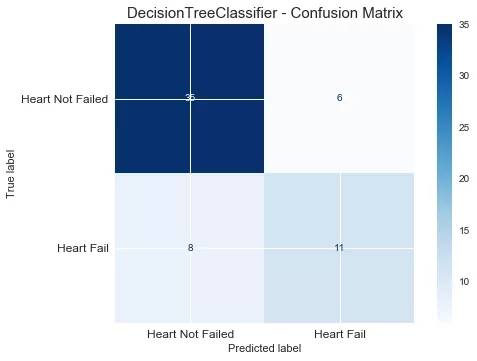
使用网格搜索进行参数调优,优化标准为f1。
parameters = {'splitter':('best','random'),
'criterion':("gini","entropy"),
"max_depth":[*range(1, 20)],
}
clf = DecisionTreeClassifier(random_state=1)
GS = GridSearchCV(clf, param_grid=parameters, cv=10, scoring='f1', n_jobs=-1)
GS.fit(X_train, y_train)
print(GS.best_params_)
print(GS.best_score_)
{'criterion': 'entropy', 'max_depth': 3, 'splitter': 'best'}
0.7638956305132776使用最优的模型重新评估测试集效果:
test_pred = GS.best_estimator_.predict(X_test)
# F1-score
print("F1_score of DecisionTreeClassifier is : ", round(f1_score(y_true=y_test, y_pred=test_pred),2))
# 绘图
plt.figure(figsize=(10, 7))
plot_confusion_matrix(GS, X_test, y_test, cmap='Blues')
plt.title("DecisionTreeClassifier - Confusion Matrix", fontsize=15)
plt.xticks(range(2), ["Heart Not Failed","Heart Fail"], fontsize=12)
plt.yticks(range(2), ["Heart Not Failed","Heart Fail"], fontsize=12)
plt.show()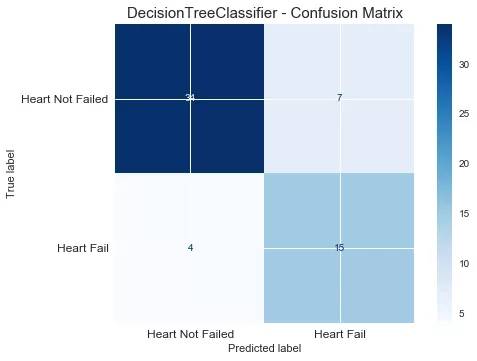
使用随机森林
# RandomForestClassifier
rfc = RandomForestClassifier(n_estimators=1000, random_state=1)
parameters = {'max_depth': np.arange(2, 20, 1) }
GS = GridSearchCV(rfc, param_grid=parameters, cv=10, scoring='f1', n_jobs=-1)
GS.fit(X_train, y_train)
print(GS.best_params_)
print(GS.best_score_)
test_pred = GS.best_estimator_.predict(X_test)
# F1-score
print("F1_score of RandomForestClassifier is : ", round(f1_score(y_true=y_test, y_pred=test_pred),2))
{'max_depth': 3}
0.791157747481277
F1_score of RandomForestClassifier is : 0.53使用Boosting
gbl = GradientBoostingClassifier(n_estimators=1000, random_state=1)
parameters = {'max_depth': np.arange(2, 20, 1) }
GS = GridSearchCV(gbl, param_grid=parameters, cv=10, scoring='f1', n_jobs=-1)
GS.fit(X_train, y_train)
print(GS.best_params_)
print(GS.best_score_)
# 测试集
test_pred = GS.best_estimator_.predict(X_test)
# F1-score
print("F1_score of GradientBoostingClassifier is : ", round(f1_score(y_true=y_test, y_pred=test_pred),2))
{'max_depth': 3}
0.7288420428900305
F1_score of GradientBoostingClassifier is : 0.65使用LGBMClassifier
lgb_clf = lightgbm.LGBMClassifier(boosting_type='gbdt', random_state=1)
parameters = {'max_depth': np.arange(2, 20, 1) }
GS = GridSearchCV(lgb_clf, param_grid=parameters, cv=10, scoring='f1', n_jobs=-1)
GS.fit(X_train, y_train)
print(GS.best_params_)
print(GS.best_score_)
# 测试集
test_pred = GS.best_estimator_.predict(X_test)
# F1-score
print("F1_score of LGBMClassifier is : ", round(f1_score(y_true=y_test, y_pred=test_pred),2))
{'max_depth': 2}
0.780378102289867
F1_score of LGBMClassifier is : 0.74
以下为各模型在测试集上的表现效果对比:
LogisticRegression:0.63
DecisionTree Classifier:0.73
Random Forest Classifier: 0.53
GradientBoosting Classifier: 0.65
LGBM Classifier: 0.74“如何用Python写出心血管疾病预测模型”的内容就介绍到这里了,感谢大家的阅读。如果想了解更多行业相关的知识可以关注亿速云网站,小编将为大家输出更多高质量的实用文章!
免责声明:本站发布的内容(图片、视频和文字)以原创、转载和分享为主,文章观点不代表本网站立场,如果涉及侵权请联系站长邮箱:is@yisu.com进行举报,并提供相关证据,一经查实,将立刻删除涉嫌侵权内容。